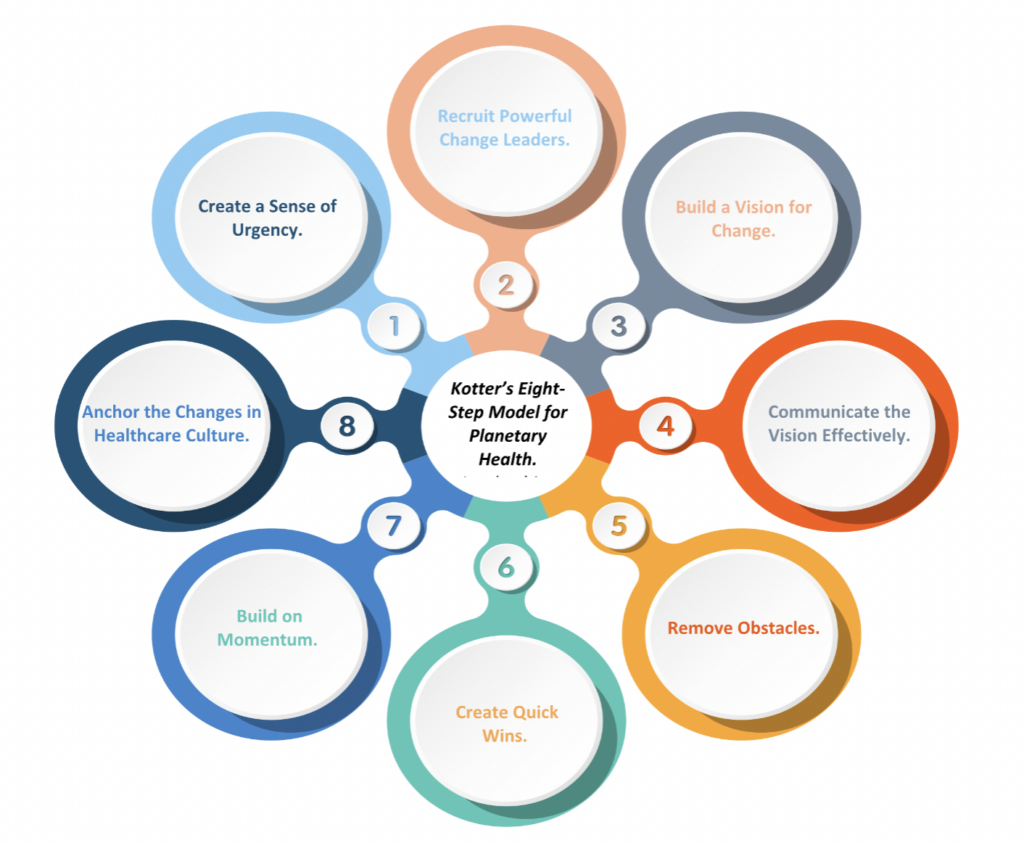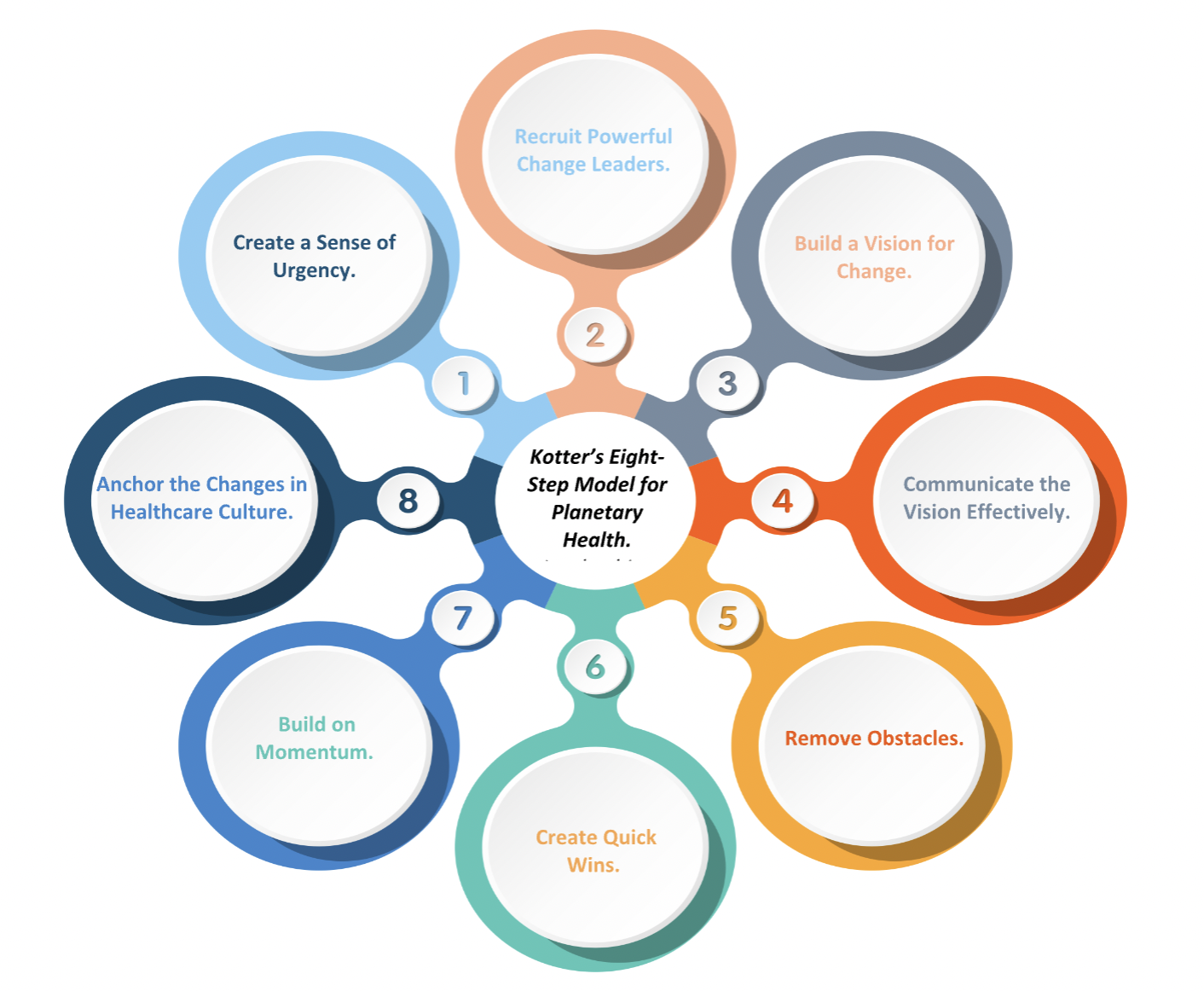As nurses and midwives, our roles as caregivers have expanded in recent years to include leadership in planetary health. We find ourselves at the intersection of healthcare and climate advocacy, uniquely positioned to lead efforts that integrate planetary health into our practices. John Kotter’s Eight-Step Model for Change Management serves as an invaluable guide in driving this transformation.
Our work is more than reactive; it is a proactive commitment to shaping the future of healthcare and its response to the growing climate crisis. Each step of Kotter’s model provides a pathway for us to reflect on the changes we are leading and the progress we are making toward a more sustainable and equitable healthcare system.

1. Create a Sense of Urgency
Climate change is not a distant threat—it is here, now, and impacting the health of our communities. From respiratory illnesses exacerbated by heatwaves to mental health challenges in disaster-prone areas, the urgency is clear. As healthcare professionals, we witness these effects firsthand, which places us in a unique position to articulate the urgency for change within the healthcare system. We can start by sharing these experiences with our peers, decision-makers, and communities to drive the conversation forward.
2. Recruit Powerful Change Leaders
No change is accomplished in isolation. To build a movement that enacts real and lasting change, we must recruit strong leaders from across healthcare and beyond. Nurses and midwives are trusted and respected voices in the community, and we must leverage this trust to engage others in positions of influence—hospital administrators, policymakers, and health sector leaders—to join our efforts in advocating for sustainable healthcare.
3. Build a Vision for Change
Our vision is clear: a healthcare system that protects both human and planetary health. As there is no human health, without a healthy planet. This is not an abstract idea, but a tangible goal where sustainable practices are integrated into every aspect of healthcare—from reducing the carbon footprint of hospitals to promoting public health strategies that address climate resilience. By crafting a clear and compelling vision for this future, we inspire others to see that planetary health is an essential part of healthcare’s mission.
4. Communicate the Vision Effectively
A powerful vision must be communicated effectively to gain traction. As leaders, we have the responsibility to articulate the vision of planetary health not just within our own circles but to a wider audience. Whether it’s through professional networks, public health campaigns, or engaging in policy debates, we must ensure that planetary health becomes a shared priority across the healthcare system. Clear, consistent messaging is key to engaging others in the movement.
5. Remove Obstacles
Change often meets resistance, and we must be prepared to tackle the barriers that stand in our way. This could involve addressing a lack of education on climate health within healthcare settings, advocating for policy reforms, or pushing for increased resources to implement sustainable practices. By identifying and removing these obstacles, we pave the way for the broader adoption of climate-resilient healthcare practices.
6. Create Quick Wins
Celebrating small victories along the way is vital for maintaining momentum. Every step forward counts, whether it’s reducing single-use plastics in clinics, integrating climate health into nursing curricula, or influencing local policy on healthcare sustainability. These quick wins build confidence in the movement and show that meaningful change is not only possible but already happening.
7. Build on Momentum
As we achieve these quick wins, we must continue building on that momentum to enact broader, more systemic changes. This involves scaling up successful initiatives and creating opportunities for continuous improvement. We can deepen our engagement by expanding sustainable healthcare initiatives, advocating for national policy reforms, and embedding climate resilience into the core values of healthcare organisations.
8. Anchor the Changes in Healthcare Culture
For change to last, it must become part of the fabric of healthcare culture. Planetary health cannot be seen as an isolated issue; it must be embedded into the everyday practices and policies that guide our work. As nurses and midwives, we have the power to lead this cultural shift, ensuring that sustainability and health equity are central to how we care for our patients and communities. By embedding these values into nursing and midwifery practice, we create a legacy of care that extends beyond our patients to the planet.
Conclusion
By embracing Kotter’s Eight-Step Model for Change, nurses and midwives are not only participating in the transformation of healthcare but are leading it. Each of us has a role to play in this journey, whether it’s advocating for sustainable practices, educating others on the health impacts of climate change, or driving policy reforms that protect our environment and our communities.
